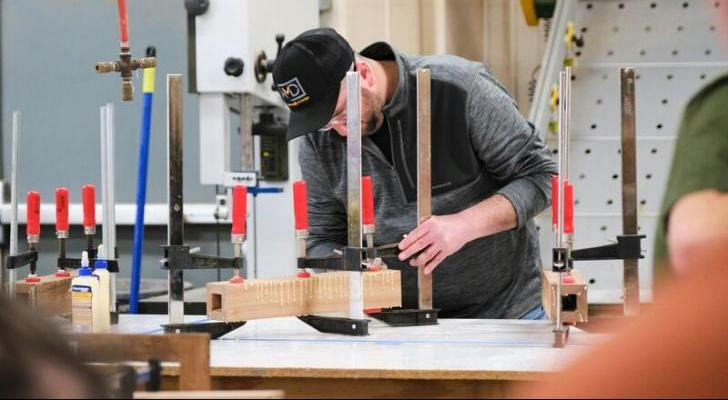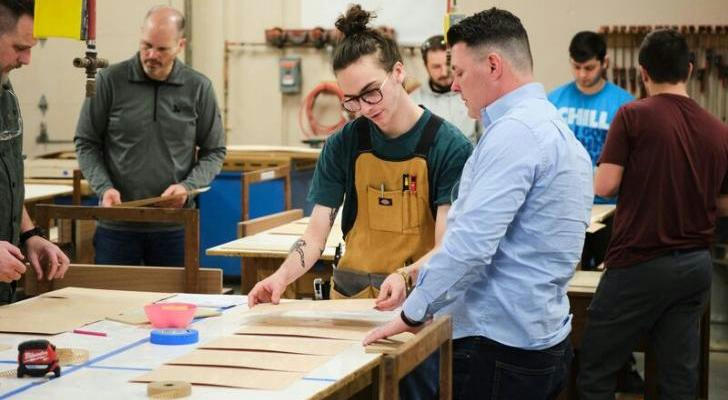Woodworking Bootcamp: Build Your Dream Furniture from Scratch
In the U.S., DIY is more than a hobby—it’s a way of life. Whether for home repairs or custom furniture, woodworking is growing in popularity.
In the United States, over 1.3 million people work in carpentry, with more than 20% learning through adult education programs (BLS.gov, 2023). Even beginners can get started and become skilled “home carpenters.”

Why More Americans Are Learning Woodworking
First, woodworking is incredibly practical. Whether it’s home repairs, custom furniture, or simple decorations, the skills are endlessly useful. Second, it’s also a great stress reliever. Many hobbyist woodworkers say that the process of cutting, sanding, and assembling wood feels like “moving meditation.”
Social media has also fueled a woodworking boom. On TikTok and YouTube, DIY creators walk viewers through their furniture builds from start to finish—often racking up millions of views. The message is clear: if they can do it, so can you.
What You’ll Learn in a Woodworking Bootcamp
Don’t be intimidated by the word “bootcamp.” With a well-structured beginner course, you can learn real, usable skills and complete your first project in just a few weeks. A typical beginner-friendly curriculum covers:
1. Woodworking Basics
Common types of wood and what they’re used for: Pine is great for beginners, while oak and walnut are ideal for advanced projects
Safety protocols: How to use goggles, gloves, and ear protection properly
2. Tool Use and Techniques
Intro to hand tools: Saws, hammers, screwdrivers, chisels
Power tool training: Drills, sanders, table saws
Measuring and cutting tips: How to mark accurately and cut clean lines
3. Hands-On Projects
Build a simple shelf or coffee table
Learn sanding, joining, and finishing techniques
Design pieces that suit your space and style
The sense of satisfaction is real—imagine telling your guests, “I built that table myself.”

How to Get Started Fast as a Complete Beginner
If you’ve never held a saw in your life, don’t worry. The hardest part is just getting started. The good news? You don’t need fancy equipment or a professional workshop to begin.
Recommended Starter Tool List (Budget-Friendly)
If you're a woodworking beginner, there's no need to worry about a large investment. You can start with a budget of under $150 and gradually build your tool collection. Many retailers, such as Home Depot, Lowe's, and Amazon, offer basic tool sets (including a cordless drill, hand saw, sandpaper, wood glue, and basic safety gear) that typically range from $100 to $150, especially if you opt for entry-level, no-brand, or bundled sets, which offer great value for the price.
You can start with the following tool list:
Cordless drill
Hand saw
Measuring tape and square
Clamps
Sandpaper and sanding block
Wood glue
Basic safety gear (goggles, gloves, mask)
These are all easy to find at Home Depot, Lowe’s, or Amazon.
At-Home Practice Tips
Start small: Think key racks, storage boxes, or floating shelves
Use scrap wood: Ask local lumberyards or neighbors for offcuts—eco-friendly and free
Practice one skill at a time: Drill holes today, saw straight tomorrow—build your confidence step by step
Where to Learn Online: YouTube and Communities
YouTube is full of accessible, beginner-friendly content. Top U.S.-based channels include:
Steve Ramsey – Woodworking for Mere Mortals: Simple and practical projects
Fix This Build That: Tool reviews and intermediate projects
The Wood Whisperer: Great for diving deeper into the craft
Join community forums like:
Reddit’s r/woodworking
Facebook’s Woodworking for Beginners group
You’ll find support, inspiration, and people who love to help others grow.
Combine Online and In-Person Learning for Faster Progress
Want a structured approach? Combine the flexibility of online learning with hands-on practice:
Skillshare: Great video classes for visual learners
Udemy: One-time purchase for lifetime access
Community colleges and adult education centers: Schools like Los Angeles Trade-Tech or NYC continuing ed programs regularly offer hands-on woodworking classes
This blended learning style is one of the quickest and most effective ways to build real, lasting skills.

The Unexpected Benefits of Woodworking
The rewards go far beyond a nice piece of furniture:
Strengthen family bonds: Build something with your kids—spend quality time and make memories
Add character to your home: Your furniture won’t just be functional—it’ll be one-of-a-kind
Boost creativity: From design to finish, every step exercises both mind and hands
If sustainability matters to you, using reclaimed wood is a great way to reduce waste while building beautiful, eco-friendly pieces.
Real Story: How Tanesha Built a New Life with Woodworking
Tanesha Wilson, a single mom from North Carolina, used to work in retail with unstable hours and income. On a friend’s suggestion, she took a woodworking class on Skillshare and followed it up with hands-on training at her local community college.
Her first project was a study desk for her daughter. To her surprise, neighbors loved it and started placing orders. She soon opened an Etsy shop specializing in children’s furniture and began sharing tutorials on Instagram. Today, she completes around ten orders a month, and woodworking has become her primary source of income.
“I never thought I could make a living with my hands,” she says. “But now, I really have.”
Conclusion: Start Building the Life You Want—One Project at a Time
Learning woodworking isn’t just about making furniture—it’s about gaining the confidence and creativity to build the life you want. No more settling for mass-produced pieces that don’t fit your space or style. You’ll be able to create exactly what you need, exactly how you want it.
If you’ve ever dreamed of building your own desk, bookshelf, or one-of-a-kind piece of furniture—there’s no better time to start than now.
